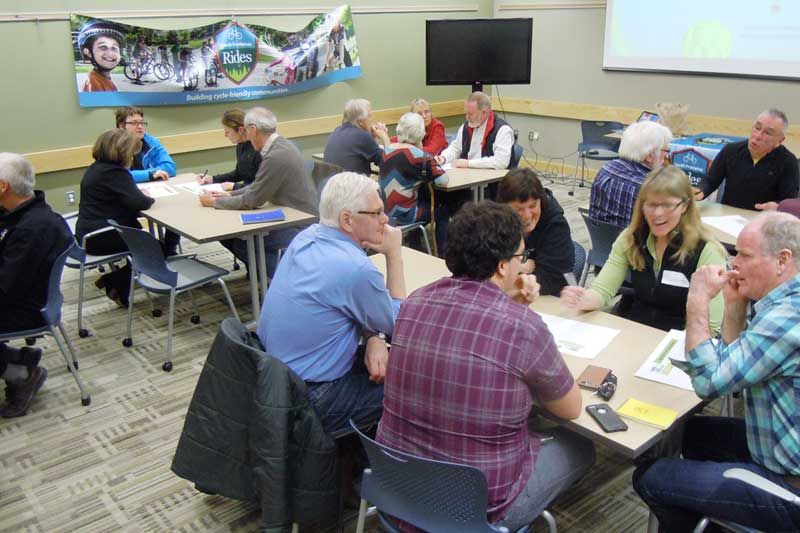Apr 07, 2016
Bicycle enthusiasts from across the Township of South Frontenac put their heads together to brainstorm what changes might be made in the township to create a more bicycle-friendly environment. The efforts began at two meetings, both of which took place on March 30 and included representatives from KLF&A Public Health, the Township of South Frontenac and South Frontenac Rides. The latter is a committee of South Frontenac Council made up almost entirely of community members interested in improving active transportation in South Frontenac.
At their first meeting on Wednesday, the three groups met privately to discuss the possibilities of coming up with a work plan to improve cycling infrastructure in the township. Guests spoke about what is currently in place in the community to support cycling and also the gaps that exist and how to best address them.
The groups developed five and two-year plans and also an immediate one-year action plan. A report is currently being created and will be presented to council in the near future. The plan will map out the suggestions identified by the stakeholders and gleaned through the lens of the Bicycle-Friendly Ontario program and will include some of the high-impact actions that the group and township can take, especially those that will have an immediate, visible impact.
The second part of the day included a public meeting where representatives from the three groups along with interested members of the community met for a presentation by Justin Jones, who is the manager of Bicycle-Friendly Ontario and is also with Share The Road Cycling Coalition.
Jones began by outlining his personal background, first as a car-dependent teenager in his hometown of Carstairs, Alberta and later, after moving to Toronto, as a cycling enthusiast. Jones cited numerous statistics in the presentation, like the fact that 54% of 18 to 34-year-olds would consider moving to another community that had better transportation options and further, that 66% of this age group said that “access to high quality transportation options” is one of their top three priorities when considering a new community to settle in.
Jones also noted that children these days are far less likely to walk or bike to school. Today only 24% (and dropping) of children do, whereas 58% of people over 30 years old used to walk or bike to school when they were children. He said, “It is very important to start reversing these trends.”
Jones went on to point to a pilot project done in the US where $25 million was invested in active transportation infrastructure (i.e. bicycle paths, trails etc.) in each of four various-sized communities. Results showed that the number of people walking went up by 22%; cyclists increased by 46-115%; and the number of collisions decreased by 18-55%.
Jones also spoke of the City of Thunder Bay, which has been increasing its active transportation infrastructure since 2010. Statistics have shown that cycling increased by 147%, and that the number of collisions involving cyclists decreased by 88%.
Jones stressed that bicycle-friendly communities involve much more than just lines on the road, but also the engineering of bike lanes, trails and bicycle parking, education, encouragements and incentives, and by-law enforcement. He spoke of the small town of Bemidji, Minnesota, which in 2012 earned bronze medal status as a bike-friendly community. The town engaged cyclists through a number of incentives and activities, which in time encouraged residents to support new cycling infrastructure policies.
In Ontario, Jones cited the town of Mississippi Mills, with a population of 12,000, which has instituted numerous cycling incentives including a small bike share program; a “Tweed Ride” where cyclists dress up in their finest for an afternoon ride; a women’s-only mountain biking event and more. Council there has passed an active transportation plan for 2016 that should see more incentives undertaken to promote cycling.
Jones also used Verona as an example. Most residents live within a 3 km radius of the town services and improved infrastructure there could see more cyclists taking to the roads to commute to their work places, schools and local services.
Following Jones’ presentation, guests were split into groups to determine what plans can be taken and put into place to increase cycling. Topics included short-term projects leading to longer-term investments; what the ideal infrastructure in South Frontenac might look like; what activities can encourage residents and children to ride; and what barriers are preventing them from doing so.
Mayor Ron Vandewal, who attended both meetings, said that he looks forward to seeing what happens with all the information gleaned from the two meetings. “There was lot of good information that came forward at both meetings and it will be interesting to see what we can do moving forward. I think that if we want taxpayers to buy into this, we also need to include other modes of active transportation like walking trails, sidewalks and more.”
More Stories
- Harrowsmith Public School and the Magic of Theatre
- You’re a Good Man Charlie Brown – a school wide effort at SHS
- Leadership From Within
- New Bulk Water Station in Sydenham
- Frontenac County Council looks at Healthcare Recruitment
- Good Turn Out Maple Fest Despite Rain
- Future looking brighter for Denbigh Fire Department says Chief
- Local Favourites featured at 2nd Annual SF Music Festival
- Perth Festival of the Maples, Saturday, April 27
- South Frontenac Council

